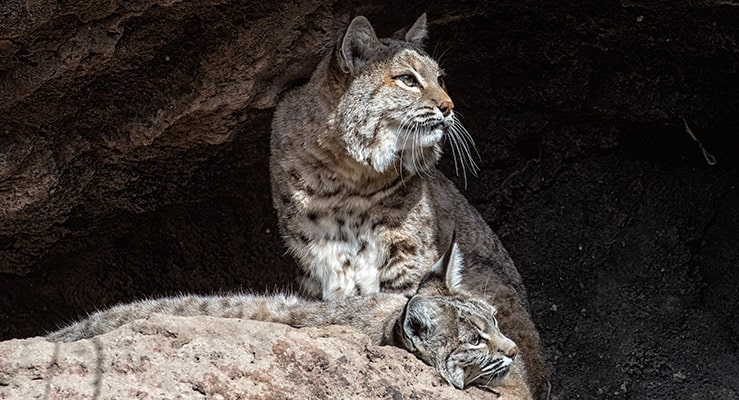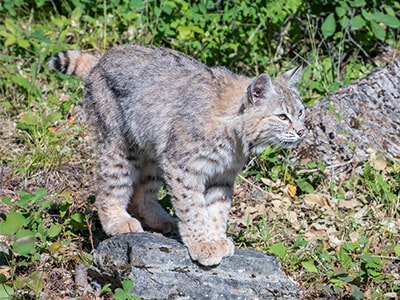Are bobcats dangerous to humans, children, and pets? Read the entire article to find out whether bobcats can be a threat to your family's safety.
Bobcats are solitary nocturnal felines found all across the United States. With their pointy ears and bobbed tails, they are twice the size of ordinary house cats but still smaller than mountain lions [1]. Despite the animal’s reclusive nature, bobcat habitats near humans are quite common. Thus, learning more about this cat is necessary and could come in handy if you ever run into one.
Of course, what most people want to know is whether bobcats are dangerous. Fearing for your safety, as well as that of your children and pets is a natural and good thing. Below, you can find everything you need to know about dealing with these animals and keeping them and yourself safe.
Are Bobcats Dangerous to Humans?
As we already mentioned, bobcats tend to be shy and keep away from humans as much as possible. However, they still live pretty close to populated areas, especially farms and the outskirts of small towns. Despite that, a bobcat will rarely attack you first. They hunt smaller prey and are not interested in humans.
Bobcats will seldom venture into towns. They might do so if they are hungry or scared. But running into one is not that common, even in areas where there are many of them. If they see that you mean them no harm, they will leave you alone. They aren’t social animals, so they won’t stay for long after they’ve spotted you.
The only time a bobcat might attack humans is if cubs are nearby. They become protective and suspicious and will defend their cubs from any threat, real or imaginary.
All in all, it’s important not to provoke them. They have sharp claws and are quite fast, so it wouldn’t take much for them to harm you. Steering clear of them is the best way to go.
Rabid Bobcats
However, things are a bit different if the cat is rabid. Rabid bobcats are dangerous and aggressive, and there’s a high chance they will want to bite you. A rabid cat’s behavior is often erratic and unpredictable. Depending on the stage the disease is in, the animal might also appear lethargic. But the one sure sign of rabies is foaming at the mouth.
If you spot a bobcat behaving strangely or see white foam coming out of its mouth, contact local animal services and notify them about the situation. They will know what to do. Staying calm and rational is pivotal.
Are Bobcats Dangerous to Children?
The same rules that apply to adults apply to children as well. Although kids are physically smaller, bobcats still won’t normally attack them first. Thus, teaching your kids to recognize and steer clear of these animals is of utmost importance. Though the chances of them running into one aren’t too high, it never hurts to be prepared, especially if you live in an area where bobcats can be found.
Are Bobcats Dangerous to Pets?
As you have read above, bobcats will not attack humans unless they are provoked. However, the same cannot be said about small pets.
Regardless of the cute clips, you see on the Internet with bobcats as pets, at their core, these wild felines are proficient predators, and they hunt small to medium-sized prey. They mostly hunt rabbits, birds, squirrels, mice, and other smaller game. Additionally, they are fast and stealthy, and their claws are rather sharp. That allows them to kill quickly, without the prey even realizing what's happening.

If the bobcat cannot catch any prey, it will have to look for food elsewhere. Typically, that means farms or small towns near the forests and mountains they usually like to inhabit. There, they will hunt for anything similar to their usual victims.
Chickens, geese, ducks, or even pet birds such as parrots are all possible targets. Small stock such as baby goats or baby sheep could also be in danger. Additionally, they will prey on smaller dogs and cats, as well as pet rabbits. Leaving your pets outside unattended in areas where bobcats are present is, thus, a bad idea.
None of the animals the cat chooses for its prey are either fast or strong enough to escape its attack. If the cat spots them, chances are that they will catch them. Bobcats usually bury their prey and come back to feed on it several times.
How to Prevent a Bobcat Attack
As we mentioned, a bobcat will rarely attack you unprovoked. So, the best way to prevent an attack is to stay out of the cat’s way. If you notice the animal closeby, don’t make any sudden movements and slowly go about your business as normal. Seeing as the cat is not social, it will go away on its own.
If you see a cat and suspect it is rabid, finding a safe place to hide is the first thing to do. Then, you need to contact animal services and have them remove the dangerous animal. Do not engage with it in any way, as its bite could be rather dangerous.
Do not leave your pets outside by themselves, especially if your garden does not have a fence. If you do, they’ll become easy prey for this feline. Always go on walks with them and keep them on a leash, so they don’t run off. Likewise, do not leave pet food outside of your house. That could lure the cat in, especially if it is hungry. It could endanger both you and your kids and pets.
If you live on a farm, keeping all your stock safely locked is the best option, especially at night. Also, make sure the fence surrounding your property is high enough, so the cat cannot jump over it. Bobcats are known to possess the capacity to jump fences that are 6 feet (1.8 m) or more in height [2].
Finally, if a bobcat does attack you or your pet, getting immediate help is pivotal. Call an ambulance as soon as possible if the cat bit a human, or call your vet if an animal was attacked. They will know how to handle the rest.
In Conclusion
Bobcats are beautiful wild cats that usually aren’t dangerous to humans. However, you need to respect nature and recognize these animals for the predators that they are. Steering clear of them and not provoking them is the best way to protect yourself, your kids, and your pets. Do so, and you will have nothing to worry about.
Resources:



